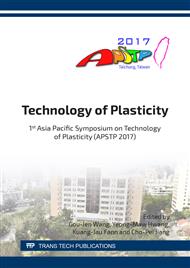[1]
C.C. Wong, T.A. Dean, J.Lin, A review of spinning, shear forming and flow forming processes, Int J Mach Tools Manuf, 43(2003) 1419-1435.
DOI: 10.1016/s0890-6955(03)00172-x
Google Scholar
[2]
Q.X Xia, G,F Xiao, H. Long, X.Q Cheng, X.F Sheng, A review of process advancement of novel metal spinning, Int J Mach Tools Manuf, 85 (2014) 100-121.
DOI: 10.1016/j.ijmachtools.2014.05.005
Google Scholar
[3]
T. Altan, A.E. Tekkaya. Sheet metal forming-processes and applications, ASM International, 2012, Chapter 13.
Google Scholar
[4]
Q.X Xia, S. Shima, H. Kotera, D. Yasuhuku, A study of the one-path deep drawing spinning of cups, J Mater Process Technol, 159(2005) 397-400.
DOI: 10.1016/j.jmatprotec.2004.05.027
Google Scholar
[5]
M. Kleiner, R. Göbel, H. Kantz, Ch. W. Klimmek, Combined methods for the prediction of dynamic instabilities in sheet metal spinning, CIRP Ann Manuf Technol, 51(2002) 209-214.
DOI: 10.1016/s0007-8506(07)61501-7
Google Scholar
[6]
L. Wang, Analysis of material deformation and wrinkling failure in conventional metal spinning process, Durham University, Durham, (2012).
Google Scholar
[7]
L. Wang, H. Long, D. Ashley, M. Roberts, P. White, Effects of the roller feed ratio on wrinkling failure in conventional spinning of a cylindrical cup, Proc IMechE B: J Eng Manuf, 225(2011):1991-(2006).
DOI: 10.1177/0954405410396024
Google Scholar
[8]
Hayama M, Study on spinnability of aluminum and its alloys, Trans Jpn Soc Mech Eng C, 45(1979) 63-72.
Google Scholar
[9]
D.K. Matlock, J.G. Speer, E.De. Moor, P.J. Gibbs, Recent developments in advanced high strength sheet steels for automotive applications: an overview, Jestech, 15(2012)1-12.
Google Scholar
[10]
Japanese Society for Plastic Processing. Jingzhi Chen, translation. Spinning Technology, China Machine Press, Beijing, 1988, pp.30-44 (in Chinese).
Google Scholar
[11]
Q.X Xia, The novel spinning technology, Science Press, Beijing, 2017 (in Chinese).
Google Scholar
[12]
Q.X. Xia, X.Q. Cheng, Y. Hu, F. Ruan, Finite element simulation and experimental investigation on the forming forces of 3D non-axisymmetrical tubes spinning, Int J Mech Sci, 48(2006) 726-735.
DOI: 10.1016/j.ijmecsci.2006.01.014
Google Scholar
[13]
Chenghe Wang, Kezhang Liu, Spinning Technology, China Machine Press, Beijing, 1986 (in Chinese).
Google Scholar
[14]
K.S Diao, M. Cao, H.M Jiang, X.P Chen, H.B Su, D.W Zhang. FEM and experiment analyses of stamping process for AHSS part, Journal of Plasticity Engineering, 17(2010) 66-69 (in Chinese).
Google Scholar
[15]
AIH Committee, ASM Metals Handbook Volume 14- forming and forging, ASM International, USA, (1988).
Google Scholar


